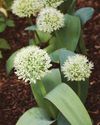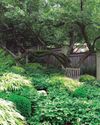
That’s where these 6 smart design tips from landscape designer and educator Rochelle Greayer can help. Follow her simple strategies and you can skip ahead to enjoying your garden instead of agonizing over it!
1 WORK FROM THE CENTER OUT, NOT THE EDGES IN
It might be tempting to start a design by working off of what’s already there. For example, many gardeners’ first beds are the borders around the property line. Instead, decide what’s most important to you, then build the design from that. In the garden above, pathways, hedges and other beds all radiate from the central beds. Maybe you really want a vegetable garden. Or maybe a shady getaway is most important to you. If that’s the case, start there, wherever it works best in your garden, and design traffic patterns, hardscaping and views to create a thoughtful, cohesive layout.
2 CHANGE THE WAY YOU THINK ABOUT CREATING PRIVACY
Most gardeners want and need privacy in their yard, and they immediately go to a tall property line hedge, wall or fence. While these are good options, they won’t be as effective if the area you want to conceal is far from the property line. Rochelle says, “Bringing things closer to obscure the view and layering plants is the best option for achieving the privacy you want.”
Esta historia es de la edición Issue 175 - February 2024 de Garden Gate.
Comience su prueba gratuita de Magzter GOLD de 7 días para acceder a miles de historias premium seleccionadas y a más de 9,000 revistas y periódicos.
Ya eres suscriptor ? Conectar
Esta historia es de la edición Issue 175 - February 2024 de Garden Gate.
Comience su prueba gratuita de Magzter GOLD de 7 días para acceder a miles de historias premium seleccionadas y a más de 9,000 revistas y periódicos.
Ya eres suscriptor? Conectar

Backyard Tornado
\"HE WHO SEARCHES FOR SPRING WITH HIS KNEES IN THE MUD FINDS IT, IN ABUNDANCE.\" - ALDO LEOPOLD

Front-of-the-Border "Wow!" Power
When it comes to easy-care plants that bring a lot of punch to the border, 'Ivory Queen' Turkestan onion should be near the top of your shopping list.

GARDEN ESSENTIALS
MAKE GARDENING EASIER THIS YEAR

Elevate an Evergreen Hedge
Although an evergreen hedge looks suitable all year on its own, it's perfectly poised to become something even greater: a backdrop to a garden where flower after flower will unfurl with such drama, you just might find yourself stepping outside and offering your applause.

One Garden, Two Worlds
In this colorful and welcoming garden, sunny, flower-filled front borders transition to a shady backyard hideaway.

on edge
Four garden pros share their go-to edging techniques.

DIANTHUS
Add fragrance, vivid color and timeless charm with this reliable, cold-hardy perennial.

2025's Best New Plants!
Are you ready to start planning for next year's garden? A few new plants might be just what you need to bring those dreams to reality.

Solve Garden Problems With Ground Covers
Are you tired of coaxing turfgrass to grow in difficult spots? In her book Groundcover Revolution, Kathy Jentz says that ground covers can be the solution to these struggles.

The Romance of Spring
With the arrival of spring, emerging perennials fill the garden with soft texture, restoring life to the harsh, often barren landscape of winter.